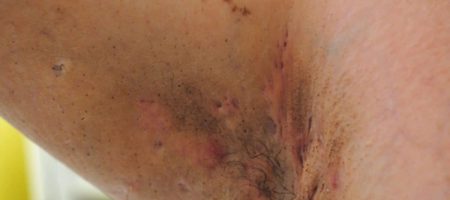Hidradenitis suppurativa

Hidradenitis suppurativa (HS), is a chronic inflammatory condition that affects sweat gland-bearing skin, usually, around the axillae (armpits), groin, buttocks (bottom) and under the breasts (inframammary fold).
It is characterised by persistent or recurrent boil-like nodules and abscesses that culminate in a purulent (pus-like) discharge that is often offensive smelling, sinuses or tunnels under the skin, and scarring.
HS can have a significant psychological impact, and many patients suffer from anxiety, depression, and impairment of body image.
Symptoms
HS can affect single or multiple areas in the axillae, neck, inframammary fold, and inner upper thighs. Anogenital involvement most commonly affects the groin, vulva, scrotum, perineum, buttocks, and perianal folds.
HS is characterised clinically by:
- Open double-headed comedones (blackheads)
- Painful, firm papules and nodules
- Pustules, fluctuant pseudocysts, and abscesses
- Draining sinuses linking inflammatory lesions
- Hypertrophic (thickened) and atrophic (thinned skin) scars.
Causes
The cause of hidradenitis suppurativa is unknown. It is thought that there is an exaggerated inflammatory response to the presence of bacteria trapped in obstructed hair follicles in the skin. In some cases, there may be a genetic component. Other factors such as obesity, smoking and stress also play a role.
Treatments
HS can be very difficult to treat and there is no single treatment that has been shown to be effective for everyone.
Affected individuals need to be supervised by a dermatologist with treatment tailored to their needs.
Lifestyle modifications such as ceasing smoking, losing weight and reducing stress are recommended.
Mild disease is treated with antibacterial washes and topical antibiotics. Acute flare-ups may be managed by oral antibiotics, intralesional corticosteroid injections and /or minor surgical procedures. Hormonal therapy and immunomodulatory (immune suppressing) agents can be useful. Biological (injectable) therapy can be used for severe, widespread cases. Other treatments include retinoids (vitamin A-like drugs) and laser treatment. Very severe cases may require radical excisional surgery.
Resources
For further information, you can visit the following resources:

